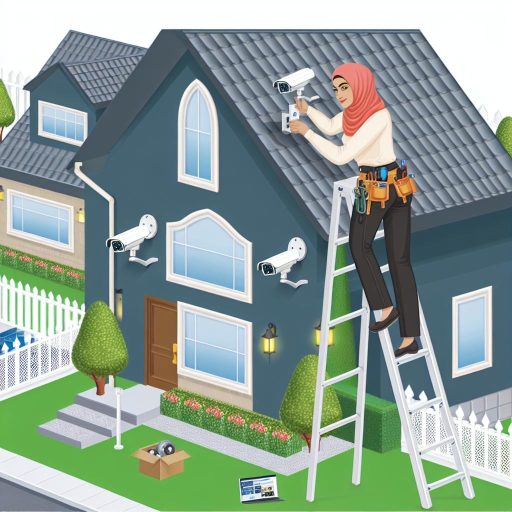Introduction to Virtual Reality in Real Estate
Virtual reality is transforming the real estate market significantly.
This innovative technology enhances how buyers tour homes.
By offering immersive experiences, virtual reality creates a sense of presence.
Homebuyers can explore properties from anywhere in the world.
This convenience saves time and expands choices for potential buyers.
Understanding Virtual Reality
Virtual reality involves creating a simulated environment using technology.
Users wear headsets that immerse them in a 3D world.
This experience allows for an interactive exploration of properties.
Moreover, it engages buyers beyond traditional photographs and videos.
The Impact on Home Tours
Virtual reality streamlines the home touring process for buyers.
It enables them to visit multiple properties in a single session.
Consequently, buyers make more informed decisions about their purchases.
Additionally, real estate agents use virtual reality to showcase listings creatively.
Benefits for Buyers and Sellers
- Buyers gain access to homes that may be far away.
- Sellers enjoy increased visibility for their listings.
- Real estate agents can attract more clients through this technology.
- Virtual reality reduces the need for physical open houses.
Future Trends in Virtual Reality
The integration of artificial intelligence will enhance virtual tours further.
Future developments may include personalized property suggestions.
This customization will cater to individual buyer preferences effectively.
Furthermore, augmented reality could complement virtual reality experiences.
Ultimately, technology will continue to shape the real estate landscape.
Historical Context of Home Tours Before Virtual Reality
Traditional Home Tours
Traditional home tours have a long history in real estate.
Agents would often host open houses for prospective buyers.
These events allowed buyers to physically walk through a property.
Consequently, buyers could assess the layout and condition of a home.
However, schedules often conflicted, limiting attendance.
Challenges Faced by Buyers
Buyers faced numerous challenges in traditional home touring.
Distance was often a major obstacle for many homeowners.
Some buyers found it challenging to visit homes during the day.
Additionally, busy schedules often left little room for touring.
These factors could discourage potential buyers from exploring options.
Real Estate Marketing Techniques
Real estate marketing used various traditional methods to attract buyers.
Agents relied heavily on printed brochures and flyers.
Photos of homes were included, but visual limitations existed.
Open houses featured prominently in marketing strategies.
However, these methods lacked interactivity and immersion.
The Shift Towards Digital Solutions
As technology advanced, the real estate industry began adapting.
Agents started using online listings to showcase properties.
These listings provided buyers with more accessible information.
However, virtual tours were still in their infancy.
Buyers happy with pictures often still preferred personal visits.
Overview of Current Virtual Reality Technology in Real Estate
Virtual reality is transforming how buyers interact with real estate.
VR technology allows potential homeowners to tour properties without leaving their homes.
Many companies now offer immersive 3D home tours.
These tours provide detailed visuals of properties from all angles.
Users wear VR headsets, creating a lifelike navigation experience.
Additionally, many platforms let users explore homes on standard screens.
Key Virtual Reality Tools in the Real Estate Industry
Several tools are essential in the VR real estate landscape.
- 3D modeling software creates realistic representations of properties.
- Virtual staging enhances the appeal of empty homes.
- Interactive walkthroughs allow buyers to customize their viewing experiences.
One popular tool is Matterport, known for its 3D imaging capabilities.
This software captures entire spaces in stunning detail.
Moreover, VR platforms often integrate video tours and high-resolution images.
The Benefits of Using Virtual Reality in Home Tours
Virtual reality offers numerous advantages to buyers.
It saves time by allowing multiple property viewings in a short period.
Further, it reduces the need for in-person visits, ensuring convenience.
Moreover, VR technology helps buyers visualize the layout and design.
This enhances decision-making and provides greater confidence in purchases.
Additionally, it engages buyers more deeply than traditional methods.
Uncover the Details: How Cloud Technology is Revolutionizing Real Estate Collaboration
Benefits of Virtual Reality for Home Buyers
Enhanced Accessibility
Virtual reality makes home tours accessible anytime and anywhere.
Buyers can explore homes from the comfort of their sofas.
This flexibility saves time and improves the home-buying experience.
Immersive Experience
VR offers a realistic experience that static photos cannot match.
Homebuyers can walk through a property as if they are actually there.
This immersion helps them envision living in the space.
Time and Cost Efficiency
Virtual reality saves buyers time by streamlining the selection process.
They can rapidly evaluate multiple homes without travel hassles.
This efficiency can significantly cut down on overall expenses.
Better Decision Making
With VR, buyers can visualize layout and design possibilities more clearly.
Such clarity allows for confident decision-making.
Buyers can focus on features that matter most to them.
Reduced Stress
Navigating the home buying process can be overwhelming.
Virtual reality can alleviate some of that pressure.
Buyers feel more in control when they choose their tours.
Opportunity for Customization
With VR, buyers can explore customization options in real-time.
They can see how different colors or materials would look in a space.
This capability enhances their engagement in the selection process.
Uncover the Details: Smart Home Technology For Voice-Activated Living Spaces
Impact of Virtual Reality on the Buyer’s Decision-Making Process
Innovative Home Touring
Virtual reality revolutionizes how buyers explore homes.
It offers immersive tours that go beyond traditional visits.
Buyers can visualize spaces like never before.
With VR, they experience homes from the comfort of their current location.
This convenience leads to quicker decision-making.
Enhanced Visualization
Virtual reality allows for 3D representations of spaces.
Buyers can see layouts and design options in vivid detail.
They gain a strong sense of scale and proportion.
This clarity eliminates uncertainty during the decision process.
Moreover, VR enables buyers to envision their future in the home.
Emotional Connection
Virtual reality fosters emotional engagement with properties.
It creates a sense of presence and belonging.
As a result, buyers form connections with spaces they tour.
This emotional aspect influences their purchasing decisions positively.
Improved Comparison
VR technology enhances buyers’ ability to compare homes.
They can easily switch between different properties virtually.
This feature allows buyers to evaluate options more thoroughly.
Consequently, they feel more confident in their choices.
Increased Accessibility
Virtual tours provide accessibility for remote buyers.
This enables individuals in different locations to view homes seamlessly.
They can tour properties with ease, without traveling long distances.
The accessibility enhances market reach for sellers.
Efficiency in the Buying Process
Virtual reality streamlines the buying process overall.
It reduces the time and effort spent on in-person visits.
Buyers can narrow their options quickly and effectively.
They focus only on homes that truly appeal to them.
This efficiency benefits real estate agents and sellers as well.
Explore Further: How Technology is Transforming Property Management for Landlords

Comparison of Virtual Reality Tours versus Traditional Open Houses
Convenience of Access
Virtual reality tours allow buyers to explore homes from anywhere.
This convenience saves time and energy for busy individuals.
On the other hand, traditional open houses require physical presence.
Traveling to multiple locations can be time-consuming.
Consequently, many buyers appreciate the flexibility of virtual tours.
Immersive Experiences
Virtual reality offers an immersive experience that traditional tours can’t match.
Buyers can feel as if they are walking through the home.
This sensation enhances the emotional connection to the property.
Traditional open houses provide a physical walkthrough but lack this level of engagement.
As a result, virtual tours can lead to quicker emotional decisions.
Safety Considerations
In the era of social distancing, safety is a priority for many buyers.
Virtual tours eliminate potential health risks associated with in-person visits.
Buyers can navigate homes without interacting with others.
This feature is especially appealing to individuals cautious about exposure.
Traditional open houses may require health screenings or masks, which can be inconvenient.
Information Availability
Virtual reality tours often include detailed information about the property.
Buyers can access specifications, features, and even neighborhood data.
This consolidated information speeds up the decision-making process.
In contrast, traditional open houses provide limited information on-site.
Consequently, buyers may have to follow up for further details.
Cost Implications
Virtual reality tours can reduce marketing costs for sellers.
Creating a virtual tour is often more affordable than hosting an open house.
Additionally, sellers can use the same tour for multiple showings.
Traditional open houses may require ongoing expenditures for staging and advertising.
Therefore, VR tours can prove to be a cost-effective option.
Find Out More: Exploring Contactless Entry Systems For Modern American Homebuyers’ Security
Successful Implementations of Virtual Reality in Real Estate
Case Study: Urban Oasis Realty
Urban Oasis Realty adopted virtual reality for property tours in 2022.
They wanted to enhance buyer engagement and streamline the viewing process.
The company invested in high-quality VR headsets and immersive software.
As a result, buyers could explore properties from anywhere in the world.
This approach significantly reduced the need for in-person visits.
Within six months, Urban Oasis Realty reported a 40% increase in sales.
Additionally, clients expressed higher satisfaction with the buying experience.
Case Study: Coastal Dream Homes
Coastal Dream Homes implemented VR tours in early 2023.
The aim was to showcase luxury properties in competitive markets.
The firm partnered with VR technology experts to create stunning visualizations.
By enabling virtual walkthroughs, they attracted a global clientele.
This innovation led to a 30% increase in inquiries about listed properties.
Moreover, it decreased the average time a property remained on the market.
Case Study: Greenfield Brokers
Greenfield Brokers started using virtual reality for interactive open houses.
They offered potential buyers the chance to explore homes at their convenience.
This method helped them stand out among traditional real estate firms.
In the first quarter of 2023, they reported a 50% rise in customer interest.
Consequently, Greenfield Brokers expanded their virtual offerings to rentals.
They now feature neighborhoods and local amenities alongside properties.
The Future of Virtual Reality in Real Estate
More companies are expected to invest in VR technology in the coming years.
The increased use of virtual reality enhances both buyer experience and market efficiency.
Furthermore, advancements in technology will improve accessibility for all buyers.
Real estate agents will continue to adapt to this evolving landscape.
Ultimately, virtual reality will transform how homes are bought and sold.
Future Trends
Immersive Experiences
Virtual reality creates immersive experiences for home buyers.
These experiences allow buyers to feel as if they are inside the home.
Additionally, buyers can interact with spaces in real-time.
This level of interaction enhances their understanding of the layout.
Advanced Technology Integration
Future advancements in VR technology will likely streamline tours.
Smart home systems may integrate with VR platforms.
As a result, buyers can preview home automation features virtually.
This integration will provide a comprehensive view of property offerings.
Increased Customization Options
Buyers may request personalized VR tours tailored to their preferences.
For instance, they can select specific features to explore during tours.
This feature increases engagement and satisfaction among potential buyers.
Accessibility and Convenience
Virtual reality will enhance accessibility for remote buyers.
Buyers can tour homes from anywhere, eliminating travel barriers.
This convenience will likely draw more participants into the market.
Collaboration with Real Estate Agents
Real estate agents will utilize VR to enhance client communication.
They can provide insights and feedback during virtual home tours.
This collaboration fosters a better client-agent relationship.
Data-Driven Insights
VR platforms will increasingly incorporate data analytics.
This data will help agents understand buyer preferences more clearly.
As a result, agents can tailor their strategies to meet client needs.
Additional Resources
AI’s Impact on Real Estate Security | First American
10 ways to use virtual reality technology in your real estate business




